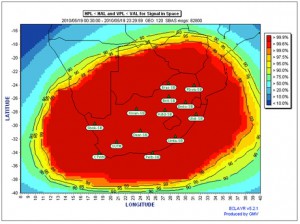Posted on: February 08, 2013

In the scope of the GSA FP7 project “SBAS Awareness and Capacity Building for South Africa” (http://www.satsa-project.eu) a pre-operational demonstrator for a Space Based Augmentation System (SBAS) adapted to the South African region has been setup. This demonstrator, which disseminates a real augmentation signal over Internet, is being used and operated by the South African Space Agency (SANSA) with two main objectives. On the one hand, it is used as a key training tool in the SBAS capacity building program included in the project. On the other hand, the SBAS demonstrator will be used during several training trials that be conducted, in collaboration with several GNSS user communities in South Africa, to show the services and performances that SBAS technology can bring to South Africa, not only for Civil Aviation but also for other applications requiring improved accuracy. The project coordinator company, GMV, installed the SBAS pre-operational prototype based on its tool magicSBAS (http://www.gmv.com/en/space/magicSBAS/index.html). Two different physical instances of the demonstrator are executing in real time: one in GMV premises in Madrid (backup instance) and the master processing center operated in SANSA Space Operation Centre in Hartebeesthoek.
The demonstrator is configured to collect GPS real-time data (observation measurements and ephemeris) from a regional network of reference stations. In South Africa, the regional network operated by TrigNet collects data from over 60 reference stations that are distributed using the NTRIP protocol. magicSBAS collects data from around 20 of those stations and computes satellite orbits and clocks, ionospheric and integrity information in order to generate the GPS SBAS correction messages (according to RTCA DO-229D) to be distributed to the final user via internet using the ESA SISNeT protocol. However, as some commercial receivers do not include SISNeT capabilities, magicSBAS also disseminates the SBAS messages emulating Virtual Reference Stations through NTRIP protocol using RTCM 2.3 format.
The real-time SBAS performances can be consulted on-line (magicgnss.gmv.com/rsa). On this web-based demonstrator, upon selection of a particular station, the right-upper quadrant shows the SBAS real-time performances for that specific receiver – displaying the evolution of the horizontal and vertical errors and protection levels which are updated every 10 seconds. Note that those position errors are computed by magicSBAS when applying the SBAS corrections to the input data and checking the position obtained against the known true position of the station defined by configuration. In the lower section of the website the real-time user level performances of the SBAS messages generated by magicSBAS are analysed by the magicGEMINI tool.
magicGEMINI receives on one side observation and navigation measurements from any configured station using the NTRIP protocol, and the SBAS message from any SISNeT server on the other. It not only computes the performance at user level for the specific location (errors, protection levels, levels of confidence) but also extrapolates the protection levels over the service area configured. Those plots are uploaded every 30 seconds to the website (in order to reduce internet bandwidth) giving an idea of the real-time performance over the South African area. It is emphasized that the SBAS signal can be acquired by interested users inside of the service area with an appropriate internet connection. Interested users are encouraged to contact the project for further information and support at satsa@gmv.com.